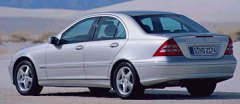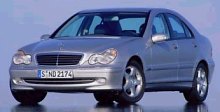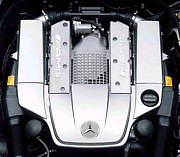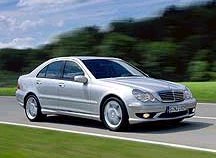 With
1.85 million cars built in 7 years, the outgoing C-class W202 is
nothing
other than successful. However, the only thing it failed to do was to
match
BMW 3-series in handling. And it was actually outclassed, thanks to the
wooden recirculating-ball steering and lack of a good chassis set up.
Admittedly,
the C-class was not really boring to drive, just the 3-series E36 and
E46
were so much improved from their predecessors. Worse of all, the newer
E46 even outclassed it in ride comfort and refinement as well. How can
its arch-rival in Stuttgart not jealous? With
1.85 million cars built in 7 years, the outgoing C-class W202 is
nothing
other than successful. However, the only thing it failed to do was to
match
BMW 3-series in handling. And it was actually outclassed, thanks to the
wooden recirculating-ball steering and lack of a good chassis set up.
Admittedly,
the C-class was not really boring to drive, just the 3-series E36 and
E46
were so much improved from their predecessors. Worse of all, the newer
E46 even outclassed it in ride comfort and refinement as well. How can
its arch-rival in Stuttgart not jealous?Now the empire is striking back with a new C-class. The exterior styling seems telling you it is serious to be young and dynamic - from the thin nose, the bonnet runs smoothly over the steeply-raked windscreen and curves towards the fast-angle rear window. Accompany with organic headlamps and smooth melting between shoulders and side windows, it looks a hundred miles more sporty than the outgoing car yet delivering a new sense of elegance. Undoubtedly, the new C-class looks prettier than the 3-series. The smooth body achieved a remarkable 0.26 drag coefficient for C180. That’s already one point better than the base E-class and S-class. Other C-class with wider tyres are 0.27. Most of the reduction of drag is achieved by the use of flat bottom tray which covers the whole engine and extend to the rear axle. Improved front air dam, skirts and the addition of rear boot spoiler also help. Despite of increased frontal area, the new C-class still deliver CdA some 13% lower than the outgoing model. Simultaneously, aerodynamic lift has been reduced by 57%.  The
chassis is no less sporty. 26% stiffer aside, it gets a new 3-link
front
suspensions (a derivative of MacPherson strut), revised multi-link
geometry
and at last, a proper steering - rack and pinion. The body just grows a
little bit - 39 mm longer, 25 mm more wheelbase, 8 mm wider and 8 mm
taller.
However, as the chassis is strengthened (for securing a top crash test
rating) and there are more standard equipment, most models are 50-60 kg
heavier. The
chassis is no less sporty. 26% stiffer aside, it gets a new 3-link
front
suspensions (a derivative of MacPherson strut), revised multi-link
geometry
and at last, a proper steering - rack and pinion. The body just grows a
little bit - 39 mm longer, 25 mm more wheelbase, 8 mm wider and 8 mm
taller.
However, as the chassis is strengthened (for securing a top crash test
rating) and there are more standard equipment, most models are 50-60 kg
heavier.Never mind, because the new car offers stronger engines model by model. The entry level C180 actually employs a 2.0 four-pot good for 129 hp and 140 lbft. Biggest selling is expected to be a low-pressure supercharged version of the same 2.0 engine, which output 163 hp and a useful 170 lbft. Next up is a 2.6-litre V6 that serves C240 (again, the name doesn’t reflect capacity). If you are not satisfy with its silky-smooth 170 hp and 177 lbft, the C320’s bigger V6 must be the answer. As you’ve heard many many times in reports concerning SLK320, CLK320, E320 and S320, the all-alloy modular 3.2-litre V6 is smooth, quiet yet powerful across a wide power band - that’s 218 hp and 228 lbft at 3,000-4,600 rpm. Well, the sohc 3-valve design and inlet-bounded VVT might not provide sufficient efficiency to match the super-punchy BMW 3-litre six, and it is also edged out by the BMW newcomer in terms of smoothness and eagerness, the Mercedes V6 still leads other competitors comfortably. It enables the C320 to sprint to 60 mph from rest in 7.4 seconds and tops 152 mph, well beating Audi A4 2.8 Quattro. Comparatively, the supercharged 2.0 is far less impressive. Although it intends to rival the six-cylinder BMW 323i, it is overwhelmingly outclassed - mushy throttle response, not all that punchy at mid-range, ugly noise ... a supercharged 4-cylinder is still a supercharged 4-cylinder. In drivetrain department, the in-house-built 5-speed automatic is undoubtedly world-leading, now even added with Tiptronic-style “One-Touch” manual override like the S-class. Another gearbox is a new 6-speed manual improved from the E-class and have already been used in SLK. However, it’s not all that pleasant to be shifted.  On
the road, the new C-class really handles fabulously, so good enough to
match with the mighty 3-series. First to be noticed is the
sharp-feeling
steering, although not as sharp as Toyota Altezza or Alfa 156, it is
accurate,
well weighted by the speed-sensitive variable servo and keeps in touch
with what’s happening on the black top. At 2.95 turns, it offers good
balance
between comfort and response. The chassis is also well tuned to deliver
sharp handling, with little body roll. As understeer has been vastly
reduced
and becomes more progressive at the limit, it overcomes twisty roads
fluently
and effortlessly. On
the road, the new C-class really handles fabulously, so good enough to
match with the mighty 3-series. First to be noticed is the
sharp-feeling
steering, although not as sharp as Toyota Altezza or Alfa 156, it is
accurate,
well weighted by the speed-sensitive variable servo and keeps in touch
with what’s happening on the black top. At 2.95 turns, it offers good
balance
between comfort and response. The chassis is also well tuned to deliver
sharp handling, with little body roll. As understeer has been vastly
reduced
and becomes more progressive at the limit, it overcomes twisty roads
fluently
and effortlessly.At the same time, ride quality is first class - probably better than the 3er. It’s supple and quiet at low speed, and the damping provides good high speed stability. That said, it rides nearly as comfortable as the S-class ! This must thanks to the new front suspension which was designed to provide better isolation from vibrations resulting from tire imbalance or brake force fluctuations. As usual, the cabin is another strength of the C-class. Although it’s just marginally larger than before, there’s still more room - especially for rear passengers - than the 3-series, because the old car was already class-leading in this respect. What impresses people most is the younger design of dashboard and console. Like the S-class, there are a lot of switches and soft-touch buttons to deliver a sense of sophistication but also confuses the driver. The instrument reading now consists of a large arc-shaped speedometer mirroring the A-class and two smaller arcs at either side of it for providing readings of rev and oil level. Inside the big arc is a screen displaying information from trip computer. Another screen locates at the center console, acting as TV or sat-nav, around which is a wooden panel. However, leather trimming is still limited to door trims and seats (depends on trim level), therefore the whole cabin remains plasticky. So, is this the new class-leader ? The new BMW 330i still goes a little bit sharper in most area, being much quicker than the C320 yet priced at the same level as C240. The baby Mercedes rides smoother, looks more handsome and provide higher level of comfort. Therefore the answer still depends on your taste. However, as the C-class now nearly matches the 3-series in dynamic aspects, life for BMW seems to be much more difficult than ever. |
| The above report was last updated on 2 June 2000. All Rights Reserved. |
 C-class
received a subtle facelift and minor modifications to address its other
weaknesses. Sportier setting of suspensions and a quicker steering rack
changed its handling character a lot. Now C-class is almost as fun to
drive as BMW 3-Series.
C-class
received a subtle facelift and minor modifications to address its other
weaknesses. Sportier setting of suspensions and a quicker steering rack
changed its handling character a lot. Now C-class is almost as fun to
drive as BMW 3-Series.  The
stiffest rival to BMW M3 has arrived. The previous C43 AMG and C55 AMG
were never able to challenge the BMW, not because of power but because
of incapable chassis. Think in this way: putting a big V8 into the nose
of a baby Mercedes could hardly achieve the right balance. The lifeless
recirculating-ball steering couldn’t help as well.
The
stiffest rival to BMW M3 has arrived. The previous C43 AMG and C55 AMG
were never able to challenge the BMW, not because of power but because
of incapable chassis. Think in this way: putting a big V8 into the nose
of a baby Mercedes could hardly achieve the right balance. The lifeless
recirculating-ball steering couldn’t help as well.
 Providing
such storming performance is a 3199 c.c. V6 modifying from C320. While
the not-so-hot sohc and 3-valve head is unchanged, there are faster cam
profile, stiffer valve springs, lighter valves, new crankshaft,
con-rods
and pistons and a 70%-higher-capacity oil pump. Needless to mention,
the
biggest change is the addition of a supercharger. Thanks to the large
90°
V-angle, the lightweight supercharger (with aluminium rotors) recesses
completely into the V-valley thus engage no more space - except that
now
there is an air-to-water intercooler added to the front. Talking about
supercharger, you might have bad impression on Mercedes’ superchargers
about their noise and vibration as seen in the 2.0 and 2.3 Kompressor.
However, this Lysholm-type (helical) supercharger supplied by Japan’s
IHI
is not the same as the cheaper root-type superchargers used by C200K
and
some SLKs. It runs seamlessly and quietly once above idle (which
generates
diesel-like noise). Engagement and disengagement are made in an unaware
manner. There is instant power from just a few hundred revs above idle.
From 2,200 to 6,100 rpm, no less than 295 lbft is ready to serve you,
proving
how flat the torque curve is. It’s not a lazy, torque-bias engine as
well,
because the redline is actually raised by 200 rpm to 6,200 rpm.
Providing
such storming performance is a 3199 c.c. V6 modifying from C320. While
the not-so-hot sohc and 3-valve head is unchanged, there are faster cam
profile, stiffer valve springs, lighter valves, new crankshaft,
con-rods
and pistons and a 70%-higher-capacity oil pump. Needless to mention,
the
biggest change is the addition of a supercharger. Thanks to the large
90°
V-angle, the lightweight supercharger (with aluminium rotors) recesses
completely into the V-valley thus engage no more space - except that
now
there is an air-to-water intercooler added to the front. Talking about
supercharger, you might have bad impression on Mercedes’ superchargers
about their noise and vibration as seen in the 2.0 and 2.3 Kompressor.
However, this Lysholm-type (helical) supercharger supplied by Japan’s
IHI
is not the same as the cheaper root-type superchargers used by C200K
and
some SLKs. It runs seamlessly and quietly once above idle (which
generates
diesel-like noise). Engagement and disengagement are made in an unaware
manner. There is instant power from just a few hundred revs above idle.
From 2,200 to 6,100 rpm, no less than 295 lbft is ready to serve you,
proving
how flat the torque curve is. It’s not a lazy, torque-bias engine as
well,
because the redline is actually raised by 200 rpm to 6,200 rpm.
 Supporting
strong performance is a capable chassis already shine in the regular
C-class.
Undoubtedly, the 3-link strut front suspension and rack-and-pinion
steering
rack provides far better steering than the old C-class. Therefore AMG
just
modified the chassis with some usual techniques - drop ride height by
30
mm and stiffened suspensions, wider tyres, larger wheels, stronger
brakes
.... the result is 70 additional kilograms compare with C320.
Strangely,
Mercedes quoted a heavy 1635 kg according to EU new regulation for
measuring
kerb weight (two up, a full tank and some luggage) so that many
journalists
thought it is heavier than C55. In fact, the correct kerb weight is
likely
to be 1560 kg, which is around 40 kg lighter than C55.
Supporting
strong performance is a capable chassis already shine in the regular
C-class.
Undoubtedly, the 3-link strut front suspension and rack-and-pinion
steering
rack provides far better steering than the old C-class. Therefore AMG
just
modified the chassis with some usual techniques - drop ride height by
30
mm and stiffened suspensions, wider tyres, larger wheels, stronger
brakes
.... the result is 70 additional kilograms compare with C320.
Strangely,
Mercedes quoted a heavy 1635 kg according to EU new regulation for
measuring
kerb weight (two up, a full tank and some luggage) so that many
journalists
thought it is heavier than C55. In fact, the correct kerb weight is
likely
to be 1560 kg, which is around 40 kg lighter than C55.
 The
re-emergence of an AMG V8 C-class was triggered by Audi S4.
Mercedes-AMG
used to overwhelm its rivals by engine displacement and torque. In the
previous generation C-class W202, AMG fitted it with a 4.3-litre V8 and
eventually a 5.5-litre version. However, the unsophisticated chassis of
the time failed to handle the extra burden at the nose thus it was
never
a real threat to BMW’s lighter and more agile M3. When Mercedes updated
the whole C-class to W203 in 2000, AMG decided to fit it with a more
compact
supercharged 3.2 V6 (which became C32 AMG) in the view of sharing cost
with SLK32 AMG, whose chassis could not accommodate a V8. However,
since
Audi introduced the V8-powered S4 last year, Mercedes-AMG found it has
to strike back with an even bigger V8. This result in the comeback of
C55
AMG.
The
re-emergence of an AMG V8 C-class was triggered by Audi S4.
Mercedes-AMG
used to overwhelm its rivals by engine displacement and torque. In the
previous generation C-class W202, AMG fitted it with a 4.3-litre V8 and
eventually a 5.5-litre version. However, the unsophisticated chassis of
the time failed to handle the extra burden at the nose thus it was
never
a real threat to BMW’s lighter and more agile M3. When Mercedes updated
the whole C-class to W203 in 2000, AMG decided to fit it with a more
compact
supercharged 3.2 V6 (which became C32 AMG) in the view of sharing cost
with SLK32 AMG, whose chassis could not accommodate a V8. However,
since
Audi introduced the V8-powered S4 last year, Mercedes-AMG found it has
to strike back with an even bigger V8. This result in the comeback of
C55
AMG.
 In
subjective terms, the normally-aspirated V8 is definitely a better
engine
than the supercharged V6, primarily thanks to its better sound quality.
Moreover, the linear torque delivery makes the car easier to exploit in
corners, thus aid handling. The gearbox seems more driver-oriented too
- it is still the AMG-enhanced 5-speed auto (disappointingly, 7G-Tronic
is not available yet), with quicker shift time than regular C-class,
but
now it has a manual mode operated via steering-wheel-mounted buttons.
In
manual mode the gearbox obeys absolutely the driver’s instructions - no
kickdown, no auto upshift at high rev.
In
subjective terms, the normally-aspirated V8 is definitely a better
engine
than the supercharged V6, primarily thanks to its better sound quality.
Moreover, the linear torque delivery makes the car easier to exploit in
corners, thus aid handling. The gearbox seems more driver-oriented too
- it is still the AMG-enhanced 5-speed auto (disappointingly, 7G-Tronic
is not available yet), with quicker shift time than regular C-class,
but
now it has a manual mode operated via steering-wheel-mounted buttons.
In
manual mode the gearbox obeys absolutely the driver’s instructions - no
kickdown, no auto upshift at high rev.